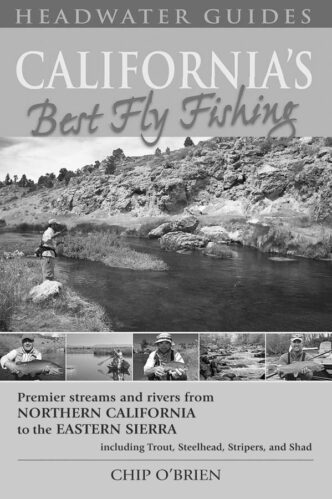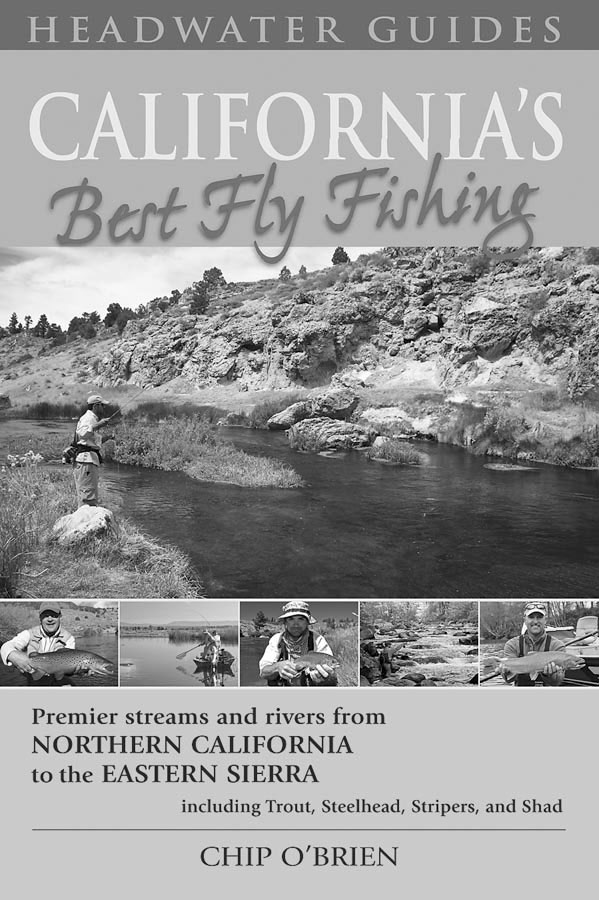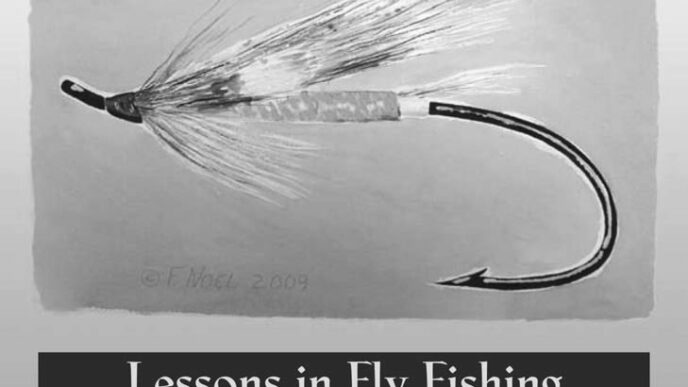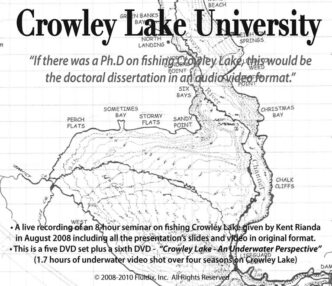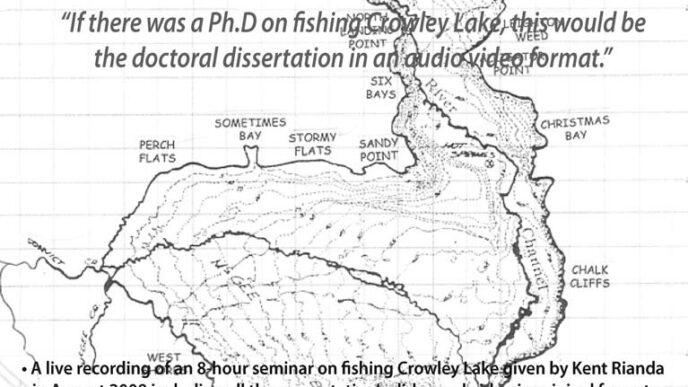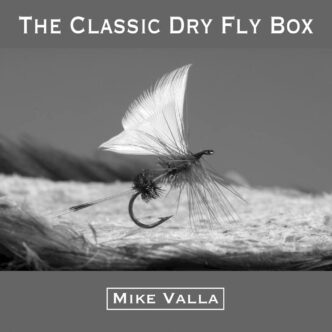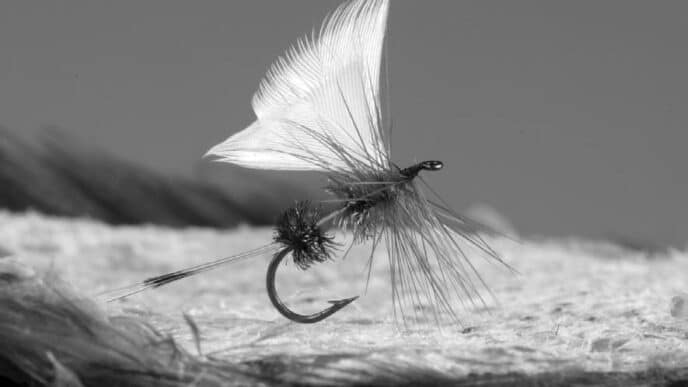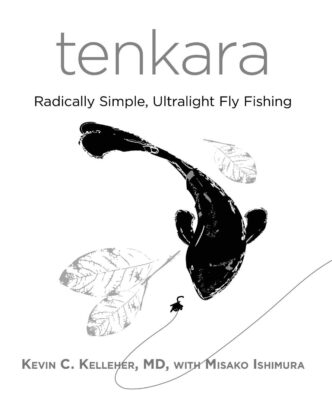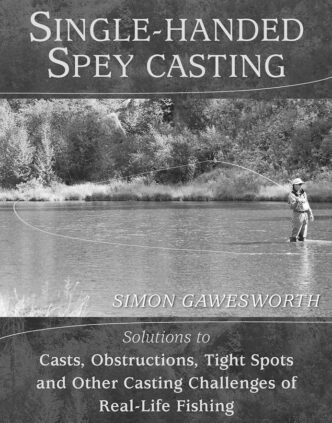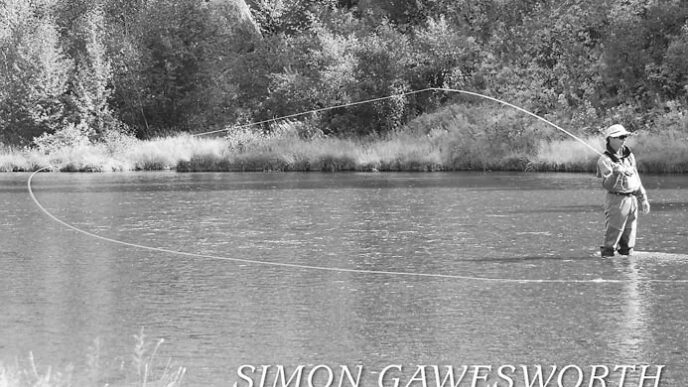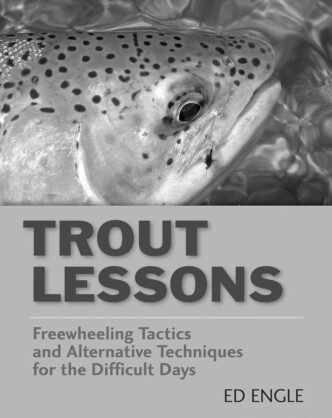California’s Best Fly Fishing
By Chip O’Brien. Published by Headwater Books, 2010; $29.95, softbound.
Chip O’Brien, of course, is no stranger to the pages of California Fly Fisher. I’ve known Chip for at least two decades, and he has always struck me as being one of the more thoughtful, good-humored, and patient guides in the business (qualities that no doubt serve him well in his profession of high-school teacher). I make these points because the credibility of a fly-fishing book or magazine article relates directly to the credibility of its author. Given his skill as a fly fisher, when Chip gives advice, I take it. And when he writes about a particular water, I can reasonably assume a level of accuracy that is born of experience and technical competence.
California’s Best Fly Fishing provides advice on how and when to fish 14 “premier streams and rivers from Northern California to the Eastern Sierra,” specifically: Hat Creek, the Fall River, the McCloud River, the Pit River, the upper Sacramento River, the lower Sacramento River, the Trinity River, Manzanita Lake, the American River (from Folsom through Sacramento), the Yuba River (from Englebright Lake to the Feather River), the Truckee River, the East Walker River, the upper Owens River, and Hot Creek. Because Chip is not merely a one-time visitor to a number of these waters, he’s able to write about how they have changed over the years, which itself is useful information (and rare in most guidebooks), because it helps us change approaches that may have become outdated.
Each chapter describes the character of a water and its sport fishery, discusses angling tactics by season, and, when important, by river section, and provides a nicely detailed map and hatch chart, along with recipes and color photographs of productive flies. These flies, by the way, are rarely common patterns, but are instead innovative designs created by observant tyer/anglers such as Mike Mercer, Tim Fox, and Ken Morrish. Some were created specifically for the water discussed, like Tim Haddon’s Dead Drift Crayfish, which was tested and evolved on the Truckee River.
Speaking of the Truckee, I read this chapter especially closely, given that I live a short distance from the river’s banks. Chip notes “The Truckee . . . is not an easy place to catch fish. It’s not a great river for beginners who need to spend a certain amount of time ‘catching’ for the fly-fishing bug to take root.” This is unvarnished truth, and it’s to Chip’s credit that he does not sugarcoat the difficulty of doing well here. Within a few paragraphs, however, Chip also claims the section of river running through downtown Truckee “is especially ignored by most anglers and, perhaps as a result, can be fairly productive.” I’m sorry, but the downtown stretch holds no fish, and if it did hold fish they won’t take flies, and if you happen to see me fishing there, well, you didn’t.
Aside from that, California’s Best Fly Fishing is a pretty useful book.
Richard Anderson
The Little Red Book of Fly Fishing
By Kirk Deeter and Charlie Meyers. Published by Skyhorse Publishing, 2010; $16.95, hardbound.
It seems as if every year somebody comes out with a collection of tips, hints, secrets, or lists, then wraps it between a couple of covers and calls it a book. Most of the tips are borrowed from older books that borrowed the tips from books that came before them. Not much presented is new, and the authors rarely actually check to see if the tips even work. Sometimes in the process myths and half truths are printed so many times that they become fact. So I wasn’t interested in this book and had no intention of reading it.
But in April, one of Lisa’s students brought The Little Red Book of Fly Fishing into class, where I idly thumbed through the pages. Thirty minutes later, I retreated to the office and ordered a copy. At $16.95, it wasn’t a tough pill to swallow.
The book is a takeoff of the Little Red Book on Golf.
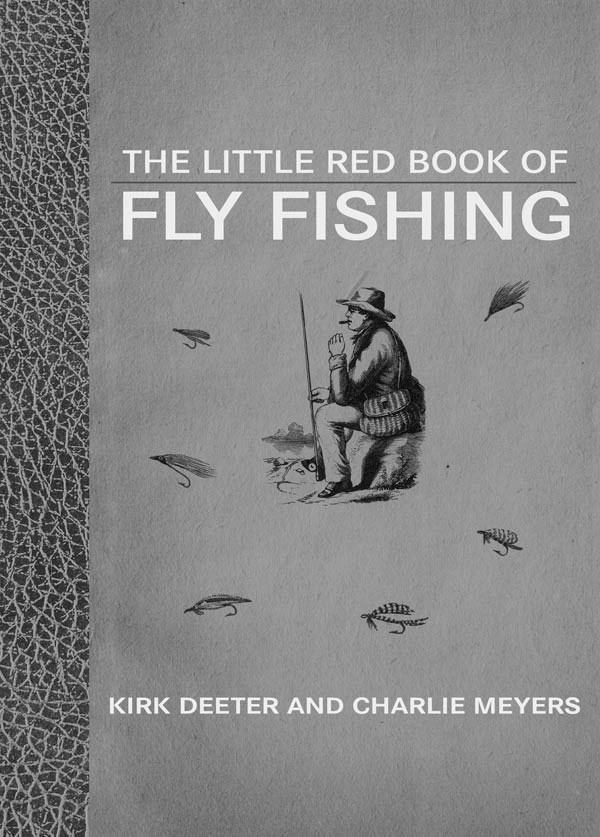
I wouldn’t have known any better except that Deeter spills the beans in his introduction. He writes: “Years ago I fancied myself a golfer, and I subscribed to the golf magazines, took lessons, and did everything I could to knock a few strokes off my game. Ultimately I found Harvey Penick’s Little Red Book of Golf to be a great resource. Its plainspoken advice, minus the swing physics and complicated theories, took strokes off my handicap. It’s a sensible, no-nonsense book. Charlie and I have tried to follow the same simple template for fly fishing.”
I think they succeeded in spades. The book is broken down into five sections: “The Cast,” “Presentation,” Reading Water,” “Bugs,” and “Miscellaneous.” Each section contains roughly fifty tips, accompanied by color photos or simple, but meaningful illustrations. Some of the tips are redundant (I think I read the tip about keeping your nymph near the bottom four times), but seeing that there is some overlap in the sections (separating casting from presenting the fly is kind of a gray zone), the duplicated tips are probably worth repeating.
Charlie Meyers is, of course, an outdoor writing icon with a lifetime of flyfishing experience. Charlie passed away in January. I’m sure he was proud to have this book as his last testament. And Kirk Deeter (author of Castwork) is no slouch when it comes to fishing difficult and varied waters. I’m certain that Meyers and Deeter actually used all the tips in this book, and they are secure enough in their domain to give credit to the guides and authors who passed along these tips to them.
Because this book was inspired by a golf manual, it is only natural that the authors frequently use golfing metaphors to illustrate or imprint some tip. If you are a golfer, these comparisons are likely to be helpful, but the only thing I know about golf was learned from watching Caddy Shack, and much of that information was lost on me. Fortunately, Deeter used the example of tossing a mug of beer into his friend’s face to simulate the start-and-stop of a casting stroke. I fully grasp that one.
This isn’t the kind of book suited to sitting in the Lazy Boy and taking it all in during one evening. It is more suited to sitting on the toilet and taking it in during brief periods of inescapable meditation. Over several weeks of short sessions, I learned a lot, and the lessons were painless and enjoyable. No matter your skill set, The Little Red Book of Fly Fishing is easily worth your time and coin.
Ralph Cutter
Bass: The Movie
A film by Jamie Howard. DVD produced by HowardFilms, 2009; $35.00 at www.HowardFilms.com.
I’m not someone who enjoys watching people fish on a television or movie screen. If I’m going to spend time watching, rather than doing, the show needs to be notably instructive, notably entertaining, or notably interesting in some other way.
Bass: The Movie certainly fits those last two criteria, given that it bills itself as “A road trip for world-class bass in a place you might not expect: the state of California.” It’s actually as much a buddy film as a road-trip film, with conventional-tackle pro bass anglers Marc Mitrany and Bobby Barrack teaming up with and providing advice to pro fly fishers John Sherman and Kevin Doran. Bass boats zoom around to productive-looking spots, lures and flies are tossed and retrieved, and bass are landed and lost, with high fives and bleeped out curses as appropriate.
Through these excursions, the viewer can learn a fair amount about fishing for bass with fly gear and conventional tackle, and it was fun to watch the interactions between John and Marc and between Kevin and Bobby. These guys showed real respect for each other. John Sherman also fishes with fly-fishing guide Larry Kurosaki, who holds a fly-caught-bass record.
The three stops on the road trip are Castaic Lagoon, which is where Larry and John fish, Lake Casitas ( John and Marc), and the Sacramento–San Joaquin Delta (Bobby, Kevin, and John). Just given the scenery, I would love to fish all three places, but the Delta especially drew my attention (and always will) with its sheer size and mystery. That’s one of the nice things about this film: We can in fact fish these waters — they’re more or less in our backyards.
The second disc included in the DVD box provides additional material on tactics and other subjects, much of it directed toward conventional-tackle anglers. That, plus PR materials that focus on pro anglers Kevin VanDam, Ish Monroe, and Mike Iaconelli — yep, I never heard of ’em, either — lead me to suspect that the target market for this film is the conventional-tackle bass angler. Whatever. I enjoyed Bass: The Movie.I learned from it. It made me want to fish. And if the soundtrack is ever released, I’m putting it into my road-trip rotation.
Richard Anderson
Stepping into the Stream
A film by Barbara Klutinis, 2010. DVD $25.00 at www.steppingintothestream.com
Stepping into the Stream is a film by a woman, for women, in which, as the DVD’s cover states, “Women fly fishers reflect on their connection to rivers, life’s experiences, and each other through their favorite sport.”
“Oh,” you’re thinking to yourself, if you’re a simple-minded kind of guy, “a flyfishing chick flick.”
Well, OK, by definition I suppose it is, but Barbara Klutinis has crafted a work that exquisitely articulates the pleasures all of us find in fly fishing. There is much wisdom in this contemplative, often lyrical film, and at the very least it reminds us, once again, that catching fish is only one element of angling, and perhaps not the most important element, at that. As Fanny Krieger observes in this film, “Whatever it is that you are looking for in life, you’ll find it in fly fishing.”
And, as Fanny also notes, “Men have finally accepted that we are here to stay.” Stepping into the Stream documents why that has happened, and why it is good.
Richard Anderson



